The Article
Lenco L-3808 Turntable: Direct Drive on a Budget
24th May 2017
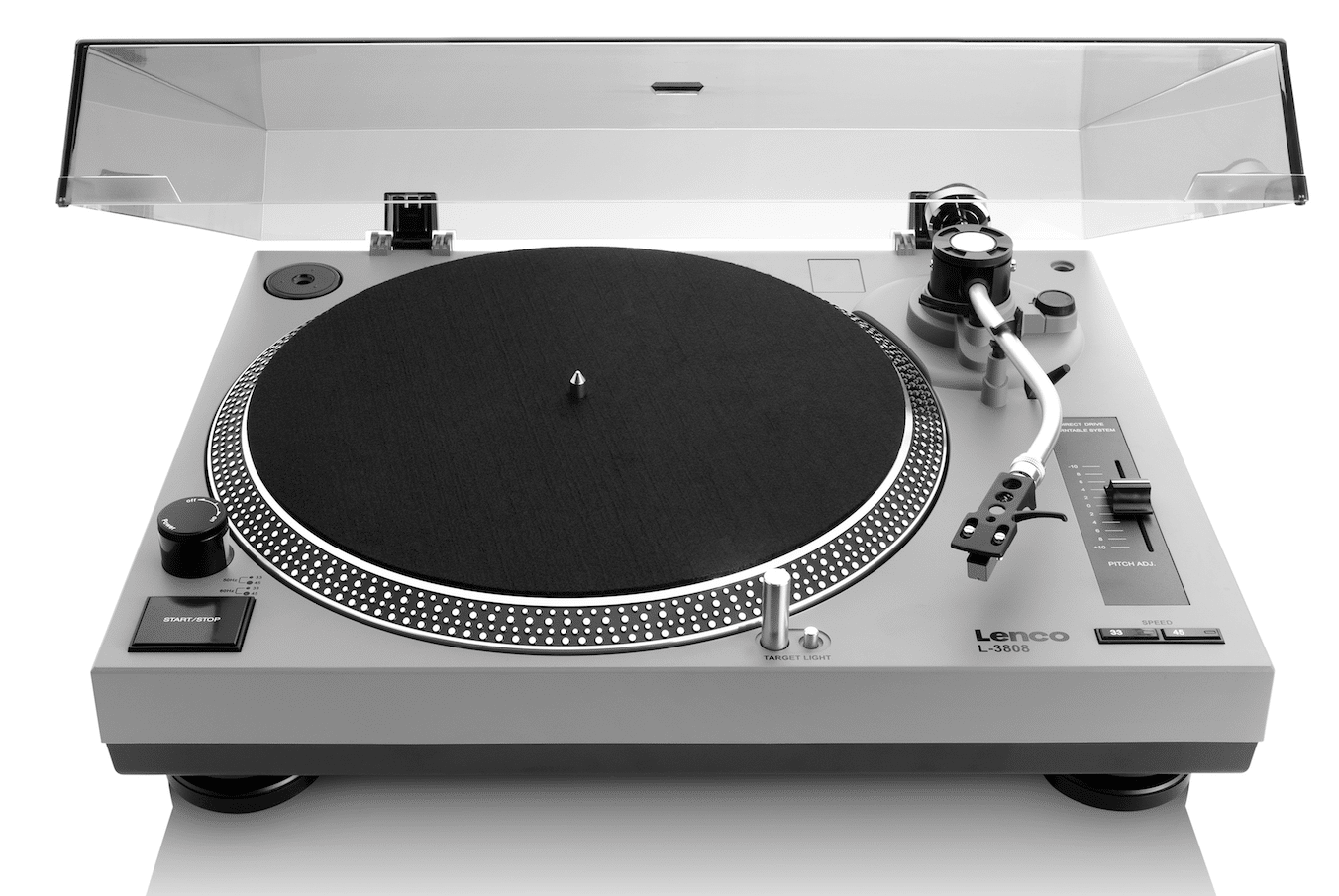
Want to go direct drive but are afraid of the expense? Lenco might have a surprise for you. Paul Rigby reviews the Lenco L-3808 (and provides a money off deal: see the end of the review)
Right, take a quick look at the price point below and then take a gander at the images and you just know that Made In China or similar is hidden somewhere within the chassis of this Lenco design. At this point the analogue snobs will lift their nose and leave the room. Still here? I’m glad, because this little turntable has a few surprises in store.
But what about that strobe light and pop-up light (for DJ use) that will immediately warn you that this might be a sad little Technics 1200 rip off? In this case, first impressions are very wrong indeed (although the turntable is recommended as an effective budget DJ tool, that’s true).
The construction is relatively solid for this price point with an all up weight of 5.4kg (the competing Dual MTR-75 weighs in at 4kg, for example).
The unit arrives with a dust cover but I would recommend removing it during play to avoid noise from its rather shaky mounting. By all means put it back, in place, when your listening session in over to protect from the dust.
The S-shaped arm looks and feels flimsy and small but it is secured well with an arm lock to prevent accidents. At the end of the arm is a removable headshell containing a standard (for this price) Audio Technica AT-3600 cartridge which Lenco asks you to run at a tracking force of 2g. Interesting because Dual, via its MTR-75 turntable, requests that you run exactly the same cartridge at around 3.25g! I know which one I’d rather place in my vinyl grooves! If you do buy yourself this deck, upgrade to a better cartridge ASAP. Something non-conical too which will enhance detail retrieval and the sonics immeasurably.
A manual turntable, beginners will be happy to see an arm lift which worked easily and well. An included moving magnet phono stage (which appears to be similar to that featured in the Dual MTR-75) is fitted within the chassis to save costs and to enable you to connect the deck to an amplifier’s line input or powered speakers. It can be switched to accept an external phono amplifier too, something that I would highly recommend as soon as you can afford one to further increase sound quality. A USB digital output is also present that can be used with the included Audacity music editing software to enable digital recording of your analogue discs. A mains cable is pre-fitted to the turntable.
IN USE
I found that, playing the turntable at 33.33, I did have to move the pitch adjustment just a tad from the default ‘0’ postion, to correct a slight speed drop.
OK, there’s no quartz control connected to the direct drive motor here, so you can’t expect nailed on speed control but it ain’t too bad once you get to grips with the pitch adjustment. The 8-pole, 2-phase design does a decent job considering the price.
Apart from that, the Lenco sprang into life without any issues.
SOUND QUALITY
I began the sound tests playing a selection of the 80s minimalist synth outfit, Bizarre Unit, combining vocals, sparse early synths with organic instruments
One of the principle failings of the budget turntable – even more so the sub-budget table – is how very much out of control it is in terms of assembling and presenting diverse frequencies to your ear. Just about everything that can go wrong normally will: blooming bass, smearing midrange and faltering stereo image with a flat soundstage and no character to any of the instruments. The Lenco addresses many of these failings from the core of one single feature: it’s direct drive motor. This single, yet essential, feature gives the turntable that one essential weapon in its sonic armoury, control. Because of the direct drive motor, there is far more focus and precision in terms of overall presentation than you would normally expect at the low, low price point.
Apart from the stereo image being rock solid and central, the bass was noticeably heavier than normal with a heft and weight that added significant presence to the entire track. Drums were meaningful and full of character, giving a foundation to the music that moved it forward at a steady pace while the midrange was, for the price, so accurate it actually created air and space in the soundstage, allowing more vocal reverb to be ‘visible’. This accuracy also infused the electric guitar with a sense of extra speed, as the transient performance improved immeasurably. The bass guitar also had more form and character. The vocals – both male and female – exuded emotion but also the delivery provided new details and nuance while the synths stopped spewing their smearing frequencies over everywhere and kept themselves to themselves. They no longer tried to mask subtle details, giving the music a richer flavour.
I then moved to the jazz vocal of Gogi Grant and the track By Myself, from the 1960 LP, Granted It’s Gogi on Living Stereo.
Grant’s wide ranging and dynamic vocal needs space and air to expand into and the Lenco, considering it’s low price point, certainly offered that. Grant fairly sparkled into a stereo image that pushed backwards as a 3D effect, allowing her big band orchestra to play around her. The focus upon her vocal allowed the ear to follow each element of her delivery with some ease.
The brass offered no brightness or stridency but, instead, had a texture through the vibrational effects of the performance giving an admirably brassy tone to this section of the backing band while keeping a measure of reverb to add energy to its effect.
Bass, from this direct drive, bounced and responded splendidly. The double bass having a notable sense of power and control on the early parts of this track. Percussion was particularly successful off this track. Partly, because the precise treble performance allowed the cymbals to offer both delicacy but also accuracy.
CONCLUSION
It’s not perfect – how can it be at £200? This is a sub-budget design so the myriad of tiny design quirks can and should be forgiven. The sound quality, meanwhile, is absolutely superb. A real shocker because it really shouldn’t be at this low, low, price. The Lenco is a solid (in plastic terms, at any rate), great sounding and easy to use turntable. A top class budget performer and a brilliant choice for anyone wanting to enter the vinyl fray.
LENCO L-3808 TURNTABLE Price: £200 Tel: 0333 1234 603 Website: www.lencouk.com TO BUY CLICK BELOW: UK - https://amzn.to/35TNWIA EUROPE - https://amzn.to/35ZtSV4
GOOD: precision, focus, ease of use, bass, price, direct drive
BAD: slight initial speed adjustment required
RATING: 9
REFERENCE
Dual MTR-75 turntable
Trichord Dino phono amplifier
Rega Brio-R amplifier
Spendor S3/5R speakers
Tellurium Q cabling
Harmonic Resolution Systems Noise Reduction Components
All vinyl was cleaned using an Audio Desk’s Ultrasonic Pro Vinyl Cleaner

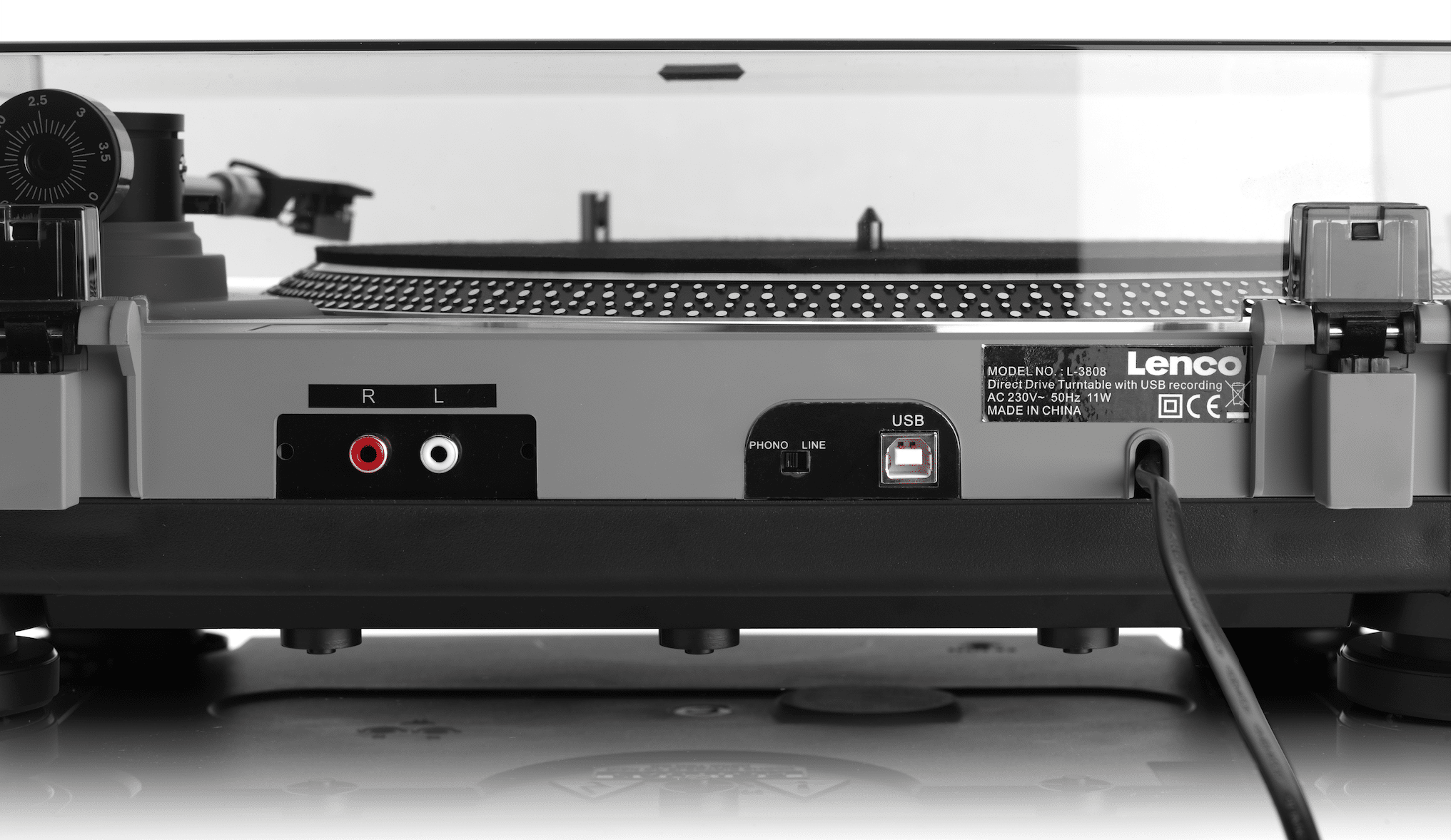
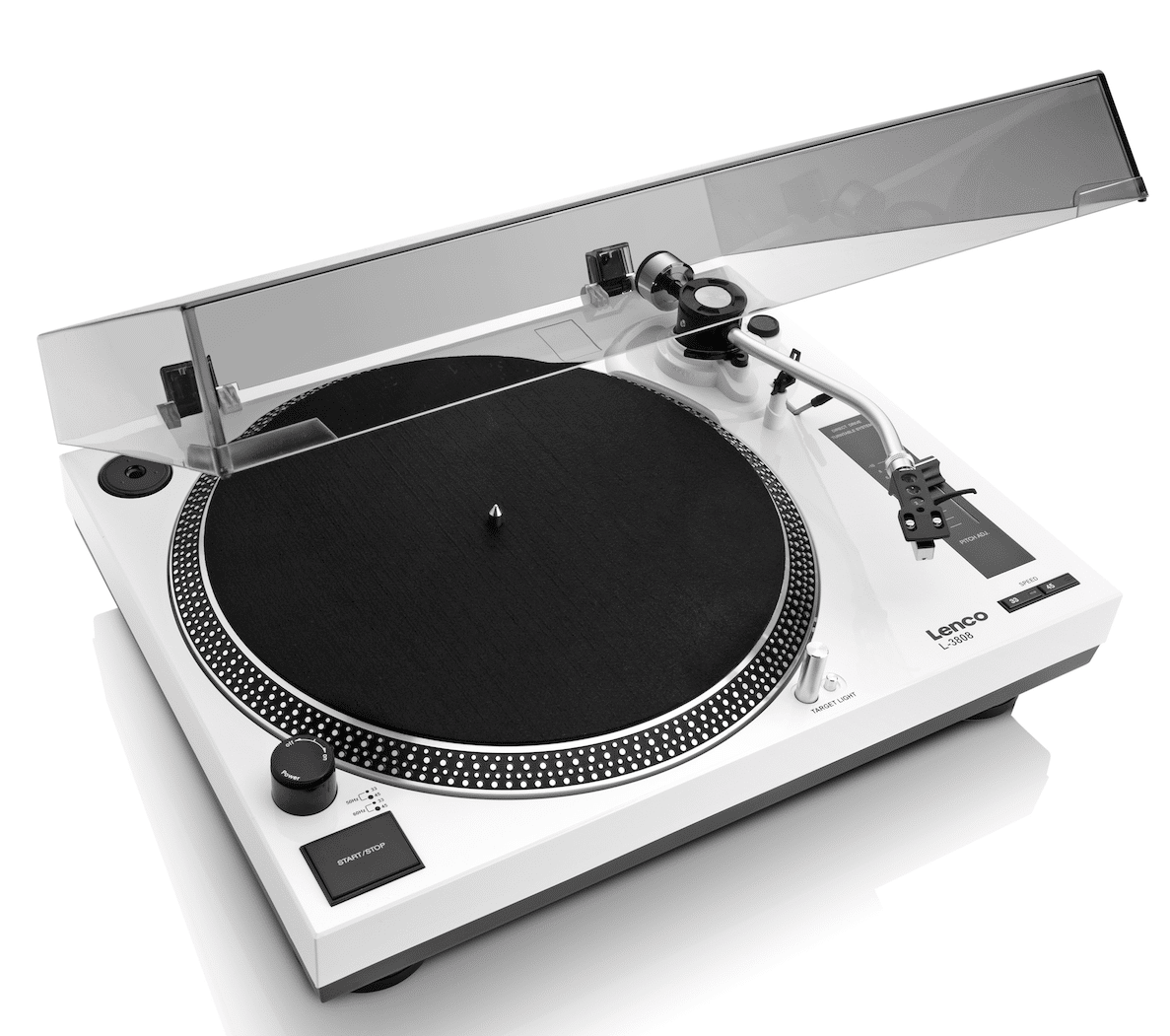
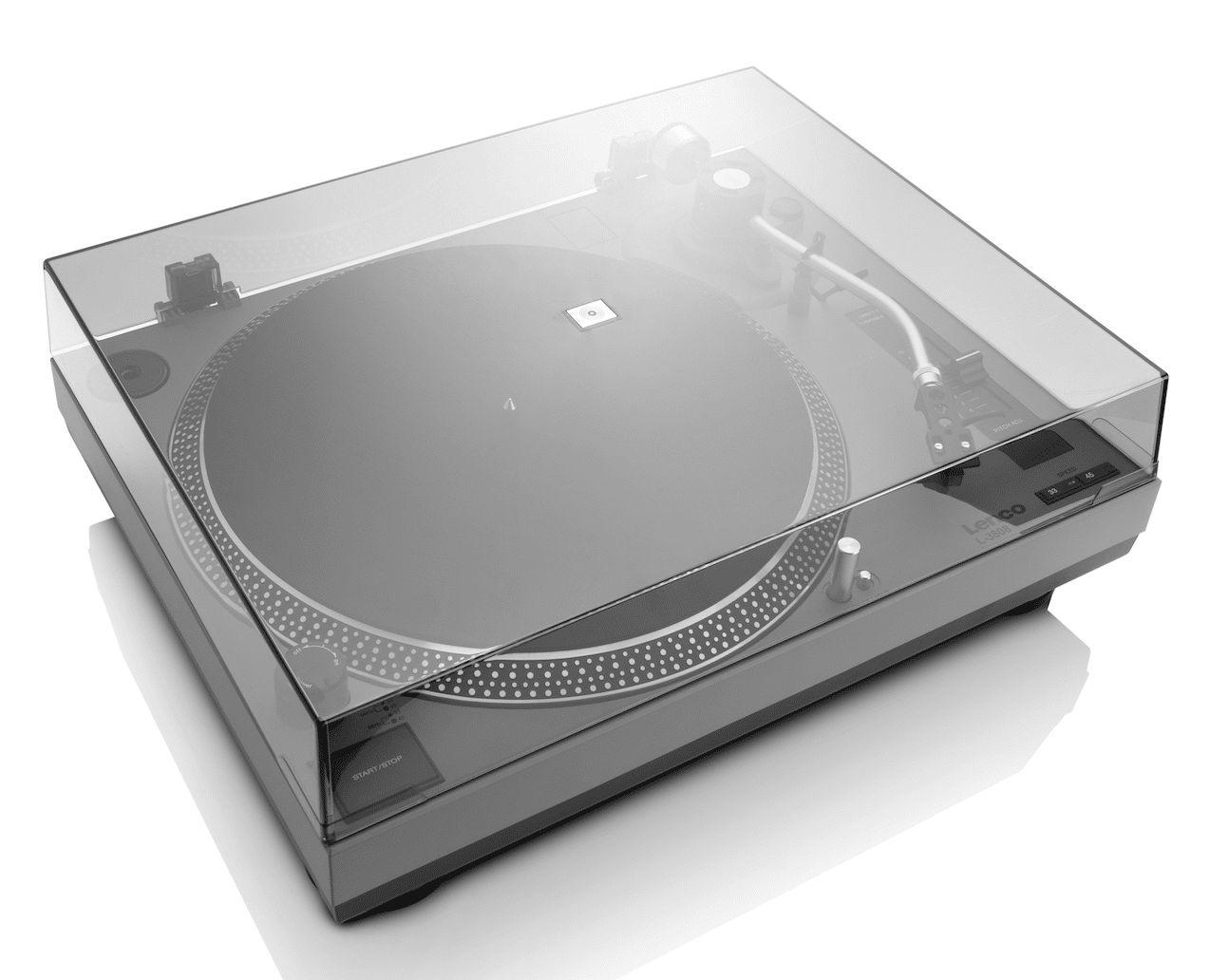
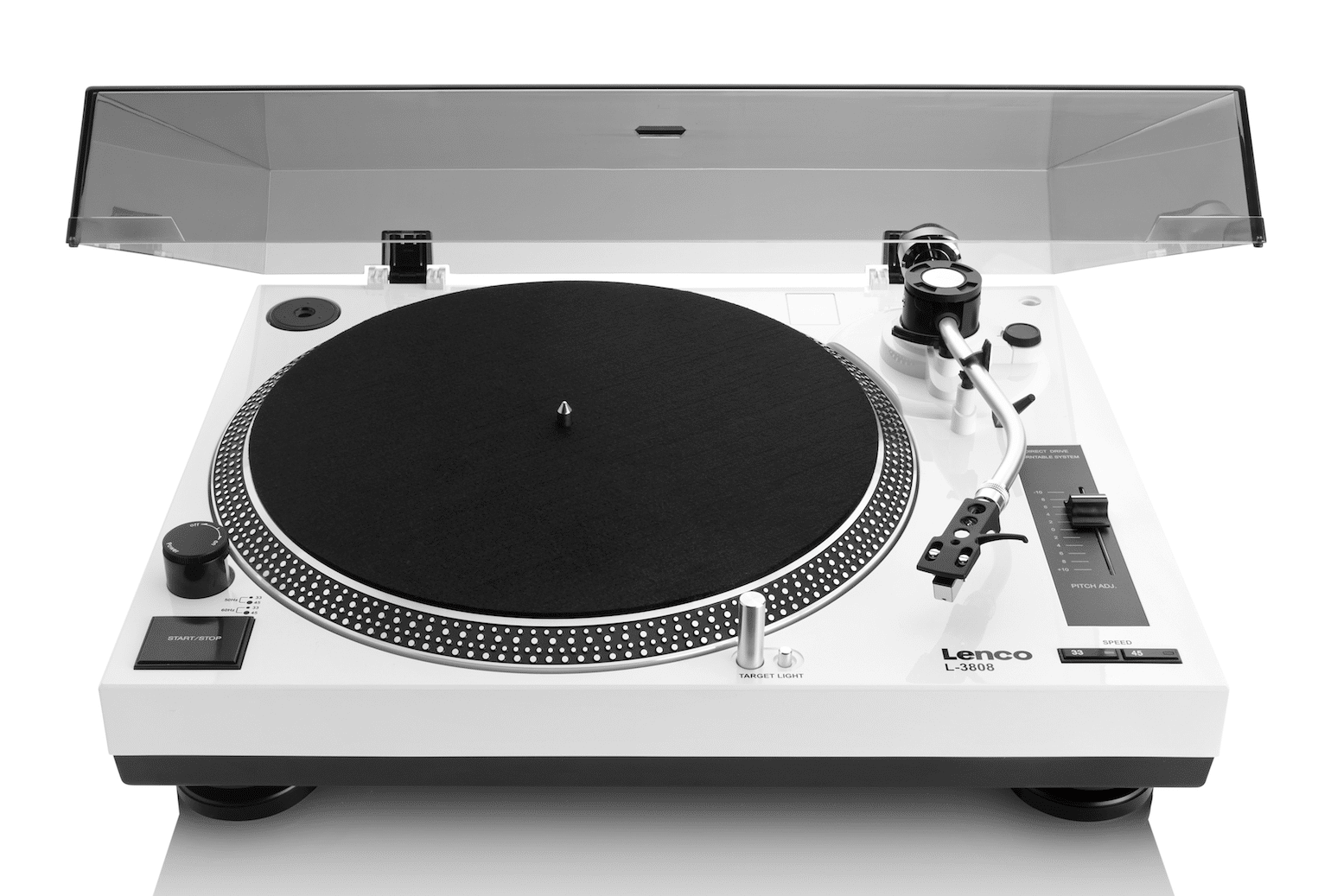
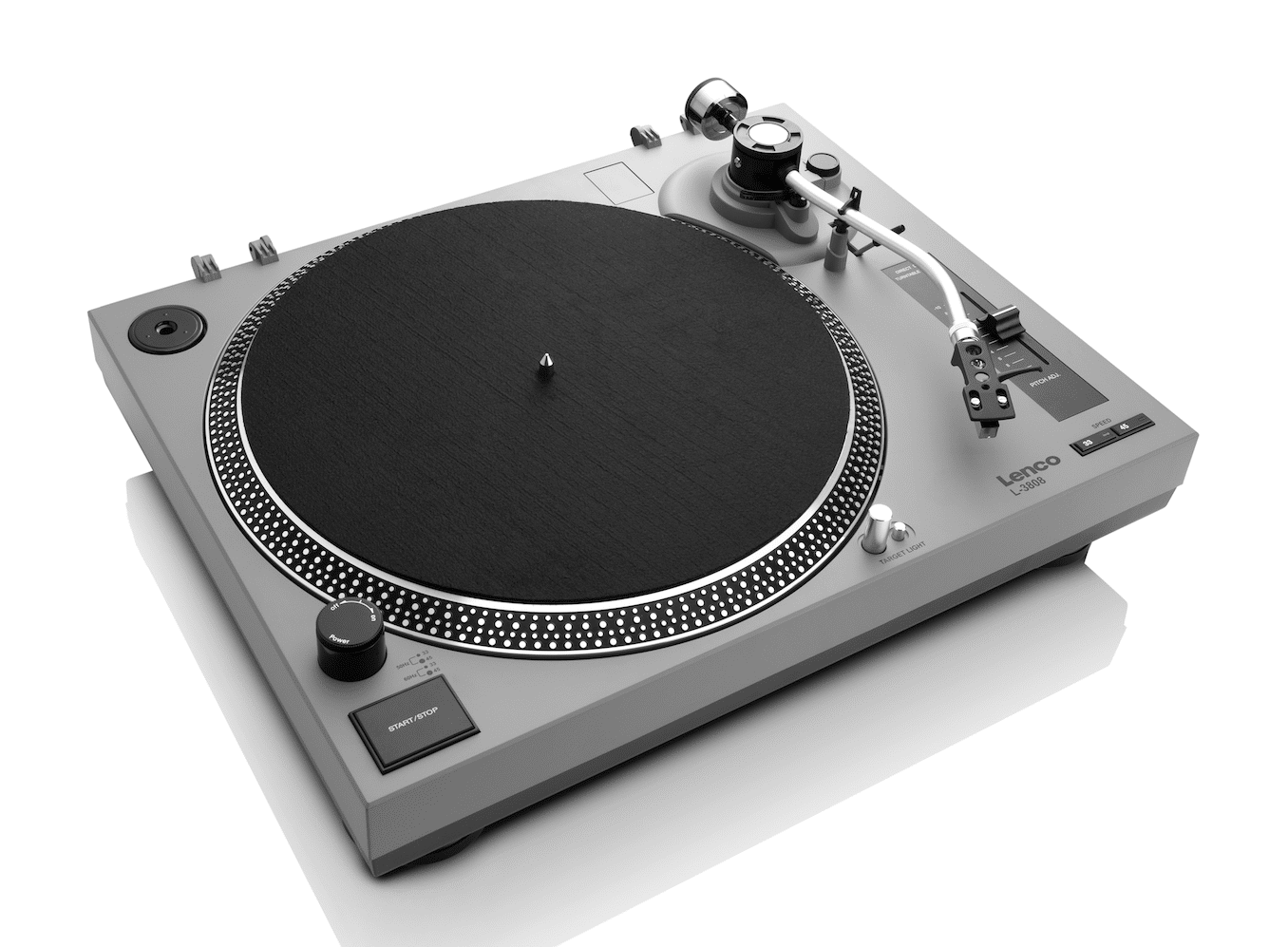


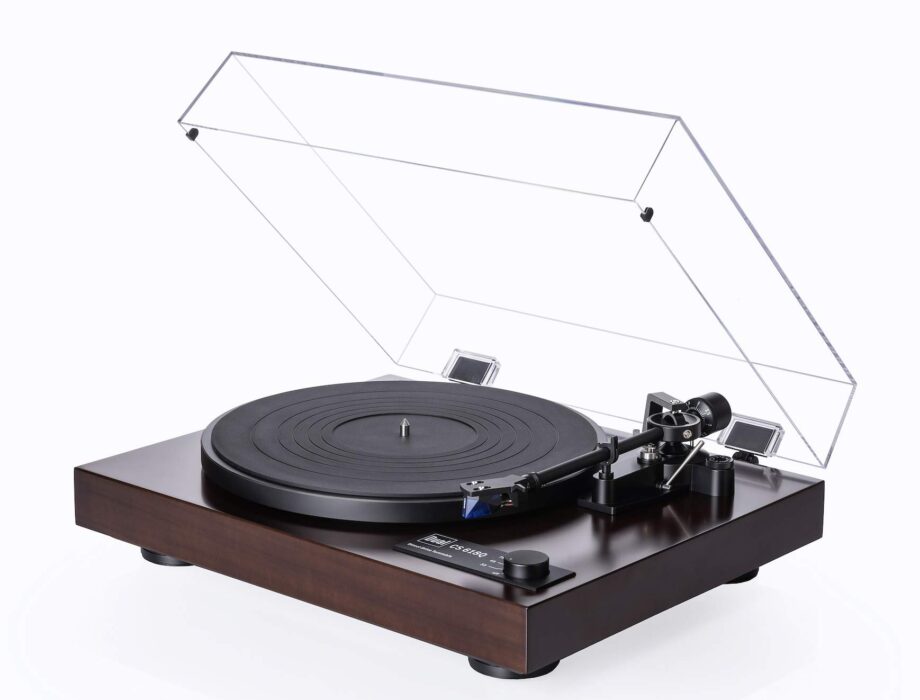
Hi Paul, i watched the cd method on YouTube searching for the turntable set up, as a novice as i am on this i thought this was common! ü§îüòÅ.
Ok i tested the values from 2 up to 3,5 and the tonearm clearly skates. Furthermore it moves to the centre when it should go to the outside as higuer is the value, is this right?.
As i told you the value i found that the tonearm doesn’t move is 1, is that really an issue? Given that the usual is that generally works on 2 or high.
Should i go ahead and try to play a vinyl or is this to risky?.
Ah! I haven’t a tracking force gauge, should this help some in this case?.
Thank you!
Hi Jose – ok, if you don’t have a gauge then you’re blind. You don’t know what tracking force you’re using, basically. You can guess using traditional manual methods. You may have seen these methods on YouTube. Slips or mistakes can happen during the set-up, though. Especially if you’re not used to this sort of thing. Get yourself a low cost digital gauge such as this one first, before you do anything else. You need a reliable tracking force measurement before you start blaming the turntable for its apparent faults: https://www.amazon.co.uk/Neoteck-Digital-Turntable-Backlight-Cartridge-Black-Black/dp/B01GJ01FGM/ref=sr_1_1?ie=UTF8&qid=1543402676&sr=8-1&keywords=turntable tracking gauge
There’s other similar gauges out there – this is just one example. Grab one of those and then repeat the installation sequence, do the tests *on vinyl* not on a CD and then get back to me if there remains an issue.
Thank you for your answer Paul, i have already bought the gauge. I’m looking forward to test it to see what actually happens.
Hello Paul!
Hope you are fine!
I m really glad that I have read the review for Lenco 3808. It is very helpful as I have a dilemma to choose between LP 120 and 3808. This review came…into the right time! I have found 3808 at the price of 170 euros (150 GBP) in Greece (Athens). Prices of LP120 start from 288 euros. You have mentioned that a change of cartridge would be proper for 3808. This is additional and improves the quality of sound. I feel ok with this.
So, to get into the point I saw a video on you tube that gives the information that you can avoid using an amplifier, as 3808 has a pre-amp built in, thus you may use active speakers, directly. What ‘s your opinion about using them, without amplifier? Could the result be proper with the sound? To be honest, I m interested in Edifier speakers, I don’t want to exaggerate…the budget.
I will really appreciate your opinion, thanks for your time!
Thanks for your comments and question Manos – it comes down to money, really. If cash or space is tight then get powered speakers because you can save money (and space) with these 2-in-1 products (i.e. you have the amplifier built into the speakers). Then again, if sound is an absolute priority and you have the cash, buy a separate amplifier.
Hi Paul,
Complete newbie to turntables and I’ve got the LENCO L-3808, apologies for the following stupid questions. I have set up the turntable but because I didn’t know I had to buy speakers (and from the comments it seems I need an amp as well?). Is this the case? Or because the LENCO L-3808 has a preamp I dont need an amp? Any you would recommend? Thanks so much and sorry for the ridiculous questions.
Thanks for the questions, James and there’s no such thing as “stupid questions” so don’t you worry about it 🙂 There is an amplifier in the Lenco but it’s a specialist gizmo. It’s there to amplify the tiny, tiny signal from the stylus. A basic amp can’t do this job. This is work for a Phono amp. That’s what is in the Lenco. From that point on yes, you need an amp. Then from there, speakers. There’s two ways you can go: either a separate amp and separate speakers or a powered set of speakers (which features an amp inside the speakers). The latter can be a cheaper option with a smaller footprint. The former takes more space, tends to be more costly but sounds better.
Thank you very much Paul this has been very helpful! What amp would you recommend? And speakers with a moderate budget?
No problem, James – what budget are you looking at?
A low to medium budget is ideal.
Do you have a figure, James? “low” and “medium” are all relative, you see 🙂
haha, I’d like to keep everything below ¬£300.
Okey dokey – for the amp, I’d look at a Cambridge Topaz AM10 which includes a phono amp: https://www.cambridgeaudio.com/gbr/en/products/hifi-and-home-cinema/topaz-am10
Now, the best type of phono amp is an external one and you can buy one from Amazon for around ¬£50 from Pro-Ject. If cash is tight, it’s better to use one in an amp than an a turntable. Push it as far from the stylus as possible to keep infecting electronic noise down.
Speakers? These are excellent: https://theaudiophileman.com/3020i-q-acoustics-speakers-review/
But you may be able to find the older 3020 models (without the ‘i’) for less if you shop around.
Thanks Paul but everything together slightly too pricey I think for me – anything for a smaller budget that you’d recommend? Thanks again!
Hi James – in terms of importance, the turntable is the most important, then the amp and then the speakers so spend more on the amp: stick with the Cambridge and then possibly look at these speakers. You can use the phono amp in the amp for now.
Hi Paul – I bought one of these based on your review for a budget 2nd system in the living room, my main spinner is a classic Lenco GL78 and I wasn’t really expecting much to be honest but for ¬£150 on Amazon at the time I thought why not. I have to say I genuinely love it, I’ve put a spare AT440-MLA Cartridge on it and it really sings on this Lenco, annoyingly I’m now starting to look at a better amp / phone amp and speakers because I think this table deserves it!
Love the website by the way
Cheers
Graham
Lovely! Very nice to hear that you’re getting along so well with the Lenco. The cartridge upgrade was a good idea too. And thanks for the kind words 🙂
Hello Paul. – l bought a L-3808 recently and upgraded the cart. to a AT-VM95E, which replaces the AT95E, even before l started looking at a suitable matching amp & speaker setup, which is enough to make any novice’s head spin. So l hope you can help me, with any recommendations. Being a budget deck, l would like the amp & speaker to be budget, also.
But l am still looking for good sound quality. And at my age, l won’t be upgrading, from whatever l end up buying.
l was thinking of between about, ¬£200/250 for each of them. But sometimes, it pays to spend a little bit more, to get a better, more superior item. l don’t mind also getting a seperate pre-amp, as you’ve said it would be better. l think a non pre-amp amplifier, and passive speakers would be best. l hope l’m not asking too much.
l’ve picked up a lot of useful information from your website, but some of your colourful descriptions of musical tones/sounds, has me scratching my head. lol
Hi Twickeree, thanks for your question. The Cambridge Topaz AM10 is a decent amplifier for £200: https://www.cambridgeaudio.com/gbr/en/products/hifi-and-home-cinema/topaz-am10.
If you want to enhance the sound, an external phono amplifier (that sits in between the deck and the amp) would be recommended: https://www.amazon.co.uk/Rega-Fono-Mini-A2D-Pre-Amplifier-black/dp/B0072RZ95U/ref=sr_1_1?ie=UTF8&qid=1551265342&sr=8-1&keywords=rega fono. That might be an added cost for you and one you want might to consider as a slightly later upgrade. If so, the amplifier has a built in phono amplifier you could use for now.
Try these speakers too – great value for money: https://theaudiophileman.com/3020i-q-acoustics-speakers-review/
As for my colourful descriptions? Well, it’s sometimes tough to try to explain a sound. As it might be difficult to try to explain the Mona Lisa in words only. If you’re ever confused about something I’ve said, though, just ask and I’ll try and put things another way.
Hi Twickeree, did you place the AT-VM95E out of the box or did you adjust it; overhang, alignment, etc? I bought one too and I am not sure what to do best.
Hi Paul. Thank you for your reply and recommendations, which l’ve considered before, as you’ve recommended them to others on here. Are those 3020i.s, passive? because l’m wondering, the deck, separate pre-amp and Topaz AM10, that’s 3 pre-amps, before the speakers. ls that too many pre-amps?, only that’s why l mentioned – “l think a non pre-amp (Main) amplifier and passive speakers would be best”- thinking that powered speakers also has a pre-amp.???
l chose the L-3808 to get my records on digital using the USB port, but l see they are also on amps and speakers (if l choose those ones). Does it matter which one (hypothetically) l connect my computer to?
l hope you won’t mind, l have a 3rd. question. l probably need suitable headphones. (neighbour does shift work). l have a Bluetooth set, that l use with my laptop when watching DVDs, but they probably wouldn’t work on the HiFi. Can you help, please?
Hi Twickree – yes the 3020i speakers are passive.
Re the amp question, to successfully hear noise from the groove on your record you need a phono amplifier. The signal is boosted just enough to then enter the main amp (the phono amp’s job is a specialist one – the main amp can’t cope with that job). Then the signal goes out to the speakers.
In your case, there is a phono amplifier in the turntable and there’s also one in the main Topaz amplifier and you can also buy an external model. The best sounding choice is the external model. When hi-fi kit is forced to sit alongside each other there’s a risk of electronic noise contamination which results in veiling noise lowering sound quality. To isolate the signal is the best choice. An external phono amp puts physical distance between it, the turntable and the main amp. Next best is the phono amp built into the Topaz. You only use this if you plug the turntable into the Topaz’s phono sockets. The worst choice is the phono amp in the Lenco because the phono amp is very close to the stylus. Contaminating noise from the Lenco’s phono amp will find its way directly to the stylus. Not a great idea but ok if cash is a problem and you have no choice.
Same with the vinyl ripping, an external ADC with an external connection is best. The Lenco’s option is not as good but acceptable if you’re on a low budget.
For Bluetooth headphones, you need a device that will send out a Bluetooth signal to be captured by your headphones. The Topaz doesn’t have one built in although you can buy a cheapo module from Amazon. Better quality sonics are to be had from wired headphones but, again, this depends on your budget.
Hi Paul. That was a quick reply. Thank you. l know how it all works, from your previous posts. l just have some specific queries that l’m not sure of. ie. l will definately buy a separate pre-amp.- (but for that, would l need to, and/or could l, then turn off the deck’s pre-amp, to use the separate pre-amp. lf so, how?), and, as l said before, can you have too many pre-amps in the system? What (non pre-amp) MAIN amplifier would you recommend, to follow on from the separate pre-amp? l say non pre-amp MAIN amplifier, because you said it produces a better sound. Also, do amps and speakers have Bluetooth connections? If not, what wired headphones would you recommend?
l don’t have a budget, as such, only what l was going to set myself, seeing that the L-3808 is a budget deck. l’m sold on the 3020i speakers and the Rega-Fono-A2Ds, not so much the Topaz AM10, mainly because it has that extra pre-amp in it. l hope l’ve explained myself to you ok, Paul.
Hi Twickeree – as you can see on P.9 of the manual here: https://www.lenco.com/uk_en/amfile/file/download/file_id/4121/product_id/2866/
you turn off the Lenco’s internal phono amplifier by flicking the rear Phono/Line switch to Phono.
Phono amps are sometimes bundled in turntables, amps and nowadays even in powered speakers. Ideally, if you have enough cash, you should buy components without a phono amplifier built in because, without bundled components, noise is lowered and sound quality improves. The fact that you have one in the Lenco is ideal for those on a low budget who cannot afford a separate phono amp. The same goes for a phono amp in an integrated amplifier like the Topaz.
In your situation, though, don’t worry about it, you can still create a good quality sound output. If you’re going to buy an external model, the Fono is a good buy, then switch off the Lenco’s internal phono amp and just don’t use the Topaz’s phono amp. The signal will be routed through the Fono and all will be well.
The Topaz, incidentally, is already a ‘main’ amplifier. There may be some confusion here. The thing that amplifies the stylus signal ready for use by an amplifier is a phono amplifier. That’s not a pre-amp. Some people call it that but that’s a recipe for confusion 🙂 The Topaz is known as an integrated amplifier. It’s called ‘integrated’ because it is a combination of two things: a pre-amp and a power amp The pre-amp essentially features the knobs, buttons on the front and most of the sockets on the rear. The power amp bit features the speaker sockets on the rear and lots of power supply bits and pieces inside the chassis. So, the Topaz is an integrated amplifier. In addition, it also comes with a ‘free’ phono amplifier, as an included accessory – signified by the Phono sockets you can see on the rear.
Some amplifiers and powered (not passive) speakers have Bluetooth – not all. For headphones, what budget are you looking at? I’ll need a figure to target specific models.
Hi Paul. Thanks for your information. At last, the fog is clearing. After spending a lot of time reading about this stuff on line and in magazines, l came to the conclusion that a phono-amp and a pre-amp was one and the same thing. Which made page 9, a contradiction. You’re the first to say that they are not. And l thank you for that. l’ll have to look at it all again, in a different light, now. But, most of my last two posts, still apply. So l won’t repeat myself. The Topaz seems to be clogged up, with stuff. So it’s only a non-intergrated amp that l need now, pref. with Bluetooth. But if not, what wired headphones would you suggest? For the budget, can l say, what are the cheapest, that will give a good sound, and do he rest of my set-up, juistice.
It’s a question of money, Twickeree – the more you spend, the more chance you have of losing that ‘stuff’. In fact, for an integrated amplifier, the Topaz has less in it than a lot in its price point. Others include DACs, Bluetooth, etc in the same chassis. If you spend a lot more then you have a greater choice. As it stands, the Topaz will provide good value for money. Basic but good wired headphones? Try the AKG K72 headphones.
You can buy an integrated amplifier with Bluetooth, if you wish but you’ll need to spend more.
Well then, Paul, if there’s a lot of integrated amplifiers out there for the same money as the Topaz, that also has DACs and Bluetooth included in them, then that’s the headphones sorted. Although, l do like the AKG K52. And better still, the AKG K92.
Thank you, for all your help, Paul. l really appreciated it. l’ve enjoyed our little “chats”. And glad we got there, in the end.
Glad I could be of help – good luck with your purchases.